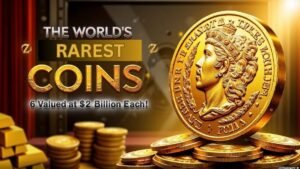The Kennedy Half-Dollar, which debuted in 1964, is among America’s most iconic coins. It was created to commemorate President John F. Kennedy after his assassinating death in 1963. While most Kennedy half-dollars are ubiquitous, some uncommon issues have become valuable, with some coins selling for as much as $150,000 at auctions. This article will examine four of the most unique Kennedy Half-Dollar coins, offer a step-by-step breakdown of how to identify them, and provide coin collecting and investment expert advice. Whether you’re a collector, investor, or just someone curious about numismatics, this guide will give you an answer as to if you have a valuable Kennedy Half-Dollar in your possession.
The Kennedy Half-Dollar continues to be one of the more interesting coins of U.S. history. Though millions of the coins were produced, some few rare versions are fetching as much as $150,000 at auction. If you’re a collector or investor, a person who’s simply rooting through pocket change, knowing how to identify these valuable coins can result in thrilling discoveries. If you believe that you own a rare Kennedy Half-Dollar, have it professionally graded to reveal its full potential.
| Coin Type | Year | Notable Feature | Auction Record |
|---|---|---|---|
| 1964 Special Mint Set (SMS) | 1964 | Satin finish | $156,000 |
| 1964 Accented Hair Proof | 1964 | Distinct hair design | $20,000 |
| 1970-D Kennedy Half-Dollar | 1970 | Limited mintage | $150,000 |
| 1967 Special Mint Set (SMS) | 1967 | Unique finish | $31,200 |
1. 1964 Special Mint Set (SMS) Kennedy Half-Dollar
In 1964, the U.S. Mint minted a few hundred Special Mint Sets (SMS) with the Kennedy Half-Dollar. They possess a satin-like appearance and crisp details, making them distinct from normal proof or circulation strikes.

Why It’s Valuable
- Extremely scarce—only a few dozen are known to exist.
- Satin finish with smooth, non-reflective surfaces.
- Auction record: A 1964 SMS Kennedy Half-Dollar in SP68 sold for $156,000 in 2019.
How to Identify It
- Finish: Satin-like, smoother than regular proof coins.
- Details: Sharper design details, especially around Kennedy’s profile.
- Mint Mark: No mint mark, made in Philadelphia.
2. 1964 Accented Hair Proof Kennedy Half-Dollar
1964 Accented Hair Proof is a highly prized Kennedy Half-Dollar. The first release of the coin had more accentuated hair above Kennedy’s ear. But Jacqueline Kennedy insisted on a change, resulting in a shortage of the original one.
Why It’s Valuable
- It was an early mint variation, hence a collector’s delight.
- This design exists only in around 1-3% of proof coins of 1964.
- Auction record: Up to $20,000 in mint state.
How to Identify It
- Hair Detail: Tighter strands above Kennedy’s ear.
- Lettering: Weak or missing lower left serif of the “I” in “LIBERTY”.
3. 1970-D Kennedy Half-Dollar
The 1970-D Kennedy Half-Dollar is the most infrequent issue of the regularly produced Kennedy Half-Dollars. The United States Mint lowered half-dollar production that year considerably, so 1970-D coins were very scarce.
Why It’s Valuable

- Low mintage—just 2.15 million coins were minted.
- Last 40% silver Kennedy Half-Dollar before the transition to a copper-nickel alloy.
- Record auction price: A 1970-D Kennedy Half-Dollar graded MS67 sold for $150,000 in 2023.
How to Identify It
- Mint Mark: Find a small “D” above the date (Denver Mint).
- Composition: Is made of 40% silver (not the standard copper-nickel composition).
4. 1967 Special Mint Set (SMS) Kennedy Half-Dollar
Due to a coin shortage in the 1960s, the U.S. Mint temporarily halted proof and uncirculated coin sets. Instead, it issued Special Mint Sets (SMS), which included the 1967 Kennedy Half-Dollar.
Why It’s Valuable
- Limited production with a unique finish.
- Auction record: A 1967 SMS Kennedy Half-Dollar in pristine condition sold for $31,200.
How to Identify It
- Finish: Satin-like, similar to the 1964 SMS version.
- Details: Sharper design elements with deep cameo contrast.

How to Know If Your Kennedy Half-Dollar Is Worth Something?
1. Look at the Date
Some of the rarest Kennedy Half-Dollars were produced in 1964, 1967, and 1970. If your coin is one of these years, it may be worth looking into.
2. Check for Mint Marks
- D = Denver Mint
- S = San Francisco Mint
- No Mint Mark = Philadelphia Mint3.
3. Inspect the Condition
Coins are graded from 1 to 70:
- MS (Mint State) 60-70 – Uncirculated, highest value.
- AU (About Uncirculated) 50-59 – Minor wear, still valuable.
- XF (Extremely Fine) 40-49 – Noticeable wear but good details.
4. Seek Professional Authentication
To really know a coin’s worth, have it professionally graded by experts:
- Professional Coin Grading Service (PCGS)
- Numismatic Guaranty Corporation (NGC)
- Investment Potential: Are Kennedy Half-Dollars a Good Investment?
Most coin collectors and investors find rare Kennedy Half-Dollars to be a good investment because of their historical value, silver content, and rarity.
Advantages of Investing in Kennedy Half-Dollars
- High demand from collectors.
- Silver content—pre-1971 coins have 40% or more silver.
- Limited series increase in value over time.
Disadvantages of Investing
- Market fluctuations—silver prices determine value.
- Needs professional authentication for maximum returns.
FAQ’S
Q. What is the most rare Kennedy Half-Dollar?
A. A circulated 1964 Kennedy Half-Dollar is valued at $11.50 to $12.25, and an uncirculated one can bring up to $5,200.
Q. Where do I sell my Kennedy Half-Dollar?
A. You can sell Kennedy Half-Dollars at:
Coin dealers
Online sites (eBay, Heritage Auctions)
Local coin shows
Q. Are there any money-value errors Kennedy Half-Dollars?
A. Yes! Search for the 1974-D Doubled Die Obverse (DDO) and the 1966 No FG (Missing Designer Initials) errors.



